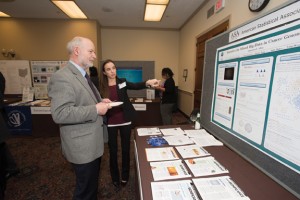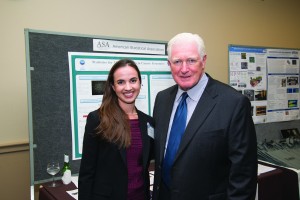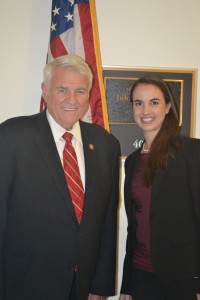ASA Participates in Capitol Hill Event Highlighting NSF-Funded Research
The annual Capitol Hill Exhibition to highlight research funding sponsored by the National Science Foundation (NSF) took place during deliberations of NSF’s fiscal year 2015 (FY15) budget and consideration of a controversial House Science, Space, and Technology Committee (HSSTC) bill reauthorizing the NSF (see sidebar).
Representing the American Statistical Association for a second straight year was Genevera Allen, a professor in the department of statistics and electrical and computer engineering at Rice University and the Neurological Research Institute at the Baylor College of Medicine, both in Houston, Texas.
On a party line vote, the House Science, Space, and Technology Committee (HSSTC) advanced in late May H.R. 4186, the Frontiers in Innovation, Research, Science, and Technology (FIRST) Act of 2014, which reauthorizes the National Science Foundation (NSF).
The scientific community has opposed the bill because of its sharp cuts to the budget for the Social, Behavioral, and Economic (SBE) Sciences Directorate, additional requirements for the funding of awards, and a lackluster funding vision.
The original bill cut the SBE budget by 40%, an amount reduced to 20% when a HSSTC subcommittee considered and advanced the bill in March. The full committee restored this cut to 40%. The bill also has additional requirements for the funding of awards that many perceive as having political undertones. Finally, following the 2007 NSF authorization to double the foundation’s budget over seven years and the 2010 reauthorization with a 10-year doubling, many criticize the HSSTC’s bill for only a 1.4% increase for FY15 over the FY14 budget.
The Senate is expected to introduce its NSF reauthorization bill before the August recess.
Visit the ASA Community blog for more information about and updates on the FIRST Act.
Texas has two members of Congress on the House appropriations panel (out of 11), which determines the NSF budget, and eight on the HSSTC (out of 40). Prior to the evening reception, Allen and ASA Director of Science Policy Steve Pierson visited the offices of both the key NSF Texas appropriators, two of the HSSTC members, and a member of Congress representing one of Allen’s institutions. Four of the offices expressed their strong support for NSF and its budget. The fifth was a freshman office still exploring the issue and receptive to Allen’s and the ASA’s messages in support of the NSF.

Genevera Allen explains her research to National Science Foundation Division of Mathematical Sciences Director Michael Vogelius.
Photo courtesy of Scavone Photography

Genevera Allen with Jim Moran (D-VA), whose district includes the ASA headquarters
Photo courtesy of Scavone Photography
While the afternoon meetings in congressional offices focused on support for NSF’s budget and policies, the evening reception highlighted the NSF-sponsored research, giving Allen an opportunity to discuss her cancer genomics research with members of Congress, congressional staff, officials from NSF and the White House Office of Science and Technology Policy, and other exhibit attendees. Allen’s poster highlighted to her audience two challenges of her Big Data research—non-Gaussian data and heterogeneous data sources—emphasizing the strengths statistical scientists bring to scientific (and societal) challenges demanding multidisciplinary research. Allen’s research team, funded by the NSF Division of Mathematical Sciences (DMS), includes an oncologist, computer scientist, and bioinformatician/geneticist. DMS Director Michael Vogelius—in his third month at NSF—and DMS Deputy Director Henry Warchall were two of the visitors to the ASA booth who spoke with Allen.
This is the fifth straight year of the ASA participating in the event, which started in 1995 and is sponsored by the Coalition for National Science Funding (CNSF). CNSF is a coalition of 130 professional societies, universities, and other stakeholders who work together to support the budget of the NSF.
If you are interested in having your department/institution represent the ASA at a future CNSF event, contact Pierson at pierson@amstat.org. (Note that preference is given to those in states whose federal delegation include members of the Commerce, Justice, and Science Appropriations Subcommittee, the panel that determines the NSF budget.)











Keep up the excellent work! Such advocacy is important for promoting the practice and profession of statistics.
mentenanta echipamente it
ASA Participates in Capitol Hill Event Highlighting NSF-Funded Research | Amstat News
Welcome!
Amstat News is the monthly membership magazine of the American Statistical Association, bringing you news and notices of the ASA, its chapters, its sections, and its members. Other departments in the magazine include announcements and news of upcoming meetings, continuing education courses, and statistics awards.
ASA HOME
Departments
Archives
ADVERTISERS
MISC. PRODUCTS AND SERVICES
Northeastern University
PROFESSIONAL OPPORTUNITIES
FDA
US Census Bureau
Software
STATA
QUOTABLE
“ …Many statisticians and data scientists are getting involved with high-impact research, analysis, and statistical support for humanitarian organizations.”
— David Corliss
Editorial Staff
Managing Editor
Megan Murphy
Graphic Designers / Production Coordinators
Olivia Brown
Meg Ruyle
Communications Strategist
Val Nirala
Advertising Manager
Christina Bonner
Contributing Staff Members
Adrian Docal
Kim Gilliam